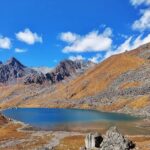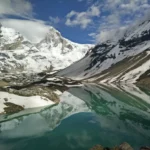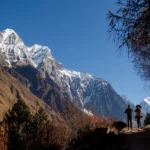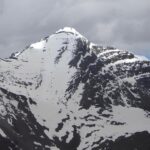The best time for Kashmir Great Lakes trek is from July to early September. While it rains incessantly in the rest of the country, Kashmir Great Lakes trek (KGL) remains comparatively dry and suitable for trekking. Although it is a peak monsoon season in the rest of the country, Kashmir receives scanty rainfall as it falls under the rain-shadow region. July to September is when the trekking season opens in Kashmir. These months are the best for witnessing the glorious beauty of Kashmir Valley.
By July, the winter snow at the higher campsites recedes, and valleys along the trail transform into flower-laden meadows. The wildflowers in the campsites are in full bloom, making KGL a memorable experience. July is the best time for Kashmir Great Lakes trek to witness its magical beauty.
Here is a detailed season-wise guide. Know more about the best time for Kashmir Great Lakes trek and plan your trip according to your interests and preferences.
Kashmir Great Lakes Trek in June
KGL Trek is a haven for trekkers who love flower-laden valleys. Higher campsites still have abundant snow making it difficult to cross the pass. The lower campsites of the trek spring up with flowers in pretty shades. You will see wildflowers blooming in white, pink, lavender, red, and pink on the lush green carpet of meadows. There will be a colour riot in the valleys of Kashmir Great Lakes in June. The trek batches for the Kashmir Great Lakes begin only in early July.
Kashmir Great Lakes Trek in July
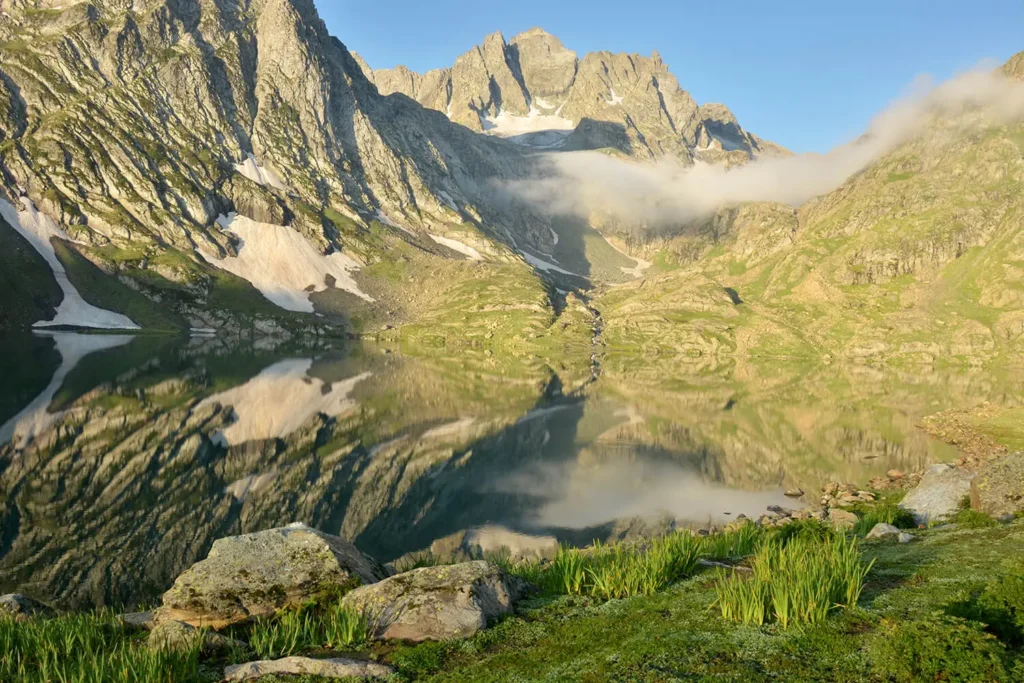
July is the most popular month for Kashmir Great Lakes trek and also the Kashmir Great Lakes’ best time. If you plan KGL trek in July, expect a long line of fellow adventure enthusiasts on the trail as July marks the beginning of Kashmir Great Lakes trek season.
There will be mild afternoon showers, however, the beauty of the trek remains unobstructed by clouds. The twin lakes of Kashmir Great Lakes remain partially frozen at the beginning of the trekking season, enhancing their beauty. These lakes are fed by snow patches sliding off the mountains. If you trek at the beginning of the season, you will witness icebergs floating on the turquoise-blue water of the alpine lakes of Kashmir.
The colour of the flowers blooming wildly in the valley changes in July. Now, distinct shades of flowers flourish wildly in KGL. Walking on flower-laden valleys on this trek is an experience of a lifetime. Experiencing Kashmir Great Lakes in July is perfect for enjoying the most glorious sights ever.
Kashmir Great Lakes Trek in August
Trekkers arriving in KGL towards July end and August will be greeted by sporadic rainfall. However, the valley and the meadows on the trek are enwrapped in dramatic colours. Fresh spell of rain enhances the beauty of Kashmir’s dramatic valleys, making August one of the best times to visit the Kashmir Great Lakes trek. Trek to KGL in August to witness wildflowers popping out of freshly misted valleys after the mild showers of July. The forest comes alive, and the scent of wildflowers is everywhere.
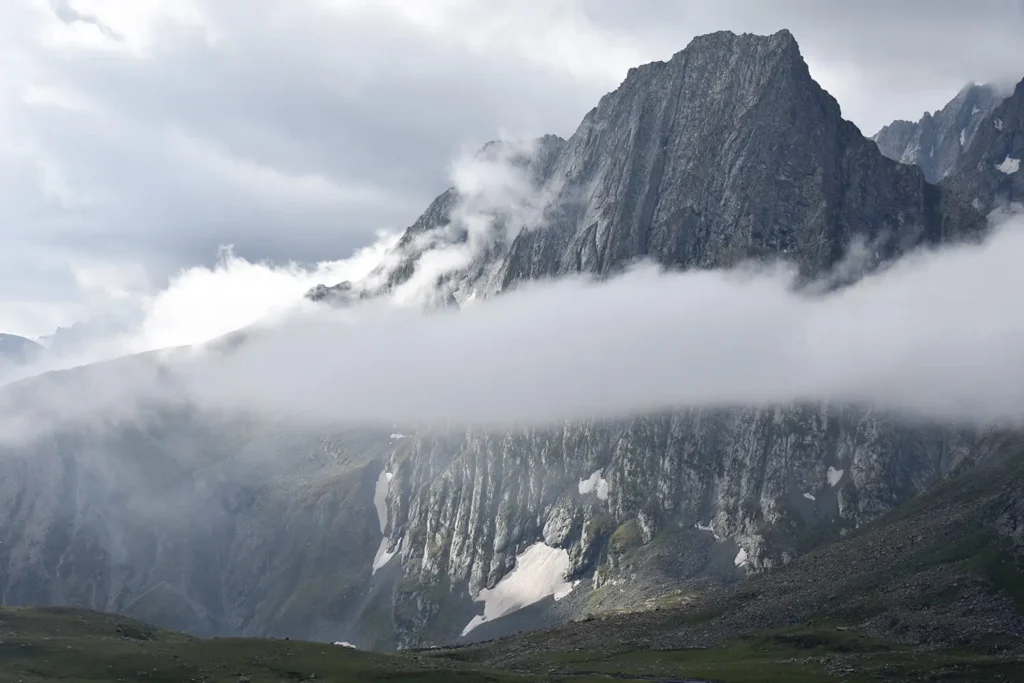
August is known for receiving afternoon showers. On most days of the trek, you will reach the campsite in the afternoon, and your trek will remain unhindered by unwanted rain.
Kashmir Great Lakes Trek in September
The entire landscape of KGL begin to alter in September. Lush green meadows of Kashmir slowly embrace brown, orange, and golden hues. As the rainfall makes its way out of the valley, the skies are clear, and there is a crispness in the air, offering the most majestic sights on Earth.
Mid-August to early September is the best time to do the Kashmir Great Lakes trek if you want to avoid the crowds of July.
Kashmir Great Lakes trek closes around mid-September. The regions sometimes start receiving snowfall by the end of September, and it becomes strenuous to access the other side of the Pass.
Kashmir Great Lakes in Winter (December to March)
Kashmir Great Lakes Trek in winter is not accessible. The trekking conditions are not favourable in Kashmir during the winter. It snows heavily in Kashmir. The trail remains buried in snow, and the connectivity also suffers due to bad weather conditions. There are frequent flight cancellations due to snow. It is also challenging to manage the trek logistically during the winter months.
Trekking to Kashmir Great Lakes during the winter months is not recommended. It is dangerous to trek in winter.
Kashmir Great Lakes Trek Highlights
As the name suggests Kashmir Great Lakes trek boasts of the unmatched beauty of Kashmir’s alpine lakes. Alpine lakes of Vishansar, Krishansar, Gadsar, Satsar, Gangabal and Nundkol Lakes are highlights of this renowned Kashmir Trek. The trek starts from a small place called Shitkadi near the famous tourist destination, Sonmarg.
Located in the Ganderbal district of Kashmir, the KGL trek is categorized as a moderate to difficult trek. The total distance of the Kashmir Great Lakes trek is around 76 km. The average distance you will cover is 8-12 km per day on the trek. The trek takes you from 7,800ft to 13,800 ft when you reach Gadsar Pass, the highest point on the trek.
The Kashmir Great Lakes trek, also referred to as the KGL trek spreads over eight days and you camp in perfectly crafted campsites. These are picture-perfect. The grandeur of KGL Trek makes this one of the most popular treks in Kashmir.
Click here to book your slot for Kashmir Great Lakes Trek
Important tips for the Kashmir Great Lakes trek
- Kashmir Great Lakes trek’s base camp is Shitkadi. Unlike other treks, here you will be staying in tents at the base camp.
- There will be no electricity or mobile network in the base camp. Remember to make important calls when you reach Srinagar. Sonmarg town is the last place where you will have a network.
- Only postpaid sim works in Kashmir. If you use a prepaid sim it will stop working the moment you land in Srinagar. Either you will have to buy a local sim from Srinagar town or change your connection to postpaid before reaching Srinagar.
- The Kashmir Great Lakes trek takes you to a maximum altitude of 13,715 ft. If you are not well prepared for the trek you can be hit by AMS. Start preparing for your trek well in advance to enjoy the trek without any obstructions. Keep yourself hydrated throughout the trek to avoid any altitude sickness. In case of any AMS, symptoms report to your Outdoor Leader immediately.
- Kashmir is a sensitive zone. Do not venture out at night in places you are not familiar with.

